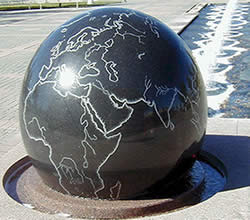This second half of “Fight or Flow” explores the alternative to the kinds of “hitting back first” reactions discussed in part one. To constructively engage with emotions requires reframing the way we think — and feel — about feelings.
It’s always amazed me that these heavy stones can move — float — on a cushion of water. The water is so calm, yet so powerful. It’s not powerful because it’s loud, fast, or fierce — the effectiveness comes from the consistency and the balance.
 I’d heard these “floating ball fountains” are used in feng-shui; I know next to nothing about that philosophy, so I emailed “Feng Shui by Design” to find out — and by the way, I didn’t mention that I was interested in emotional intelligence. A consultant named SuZen wrote that water symbolized “movement, money, and/or emotion.” The ball, she said, “represents the self — so we can choose to sink in the emotions or float with the emotions.”
I’d heard these “floating ball fountains” are used in feng-shui; I know next to nothing about that philosophy, so I emailed “Feng Shui by Design” to find out — and by the way, I didn’t mention that I was interested in emotional intelligence. A consultant named SuZen wrote that water symbolized “movement, money, and/or emotion.” The ball, she said, “represents the self — so we can choose to sink in the emotions or float with the emotions.”
Wow! That’s just what we say about emotional intelligence — emotion is powerful, and we can choose to use that power or to conflict with it.
The challenge, for me, is to discover the effortlessness — the opposite of “Hitting Back First.” Some people call it surrender, some call is peace, some call it “the zone.” How, in the midst of the stress of daily life, do I use my emotion as a source of power and effortlessly float like the stone?
Caught Up in Conflict
First, let’s revisit the strife. I’ll use myself as an example, but you might be very different; what’s challenging for me might be easy for you — so think about what’s challenging for you. When it’s easy, it’s easy! It’s the challenges that require a stretch.
 In Part One, I suggested you invest time becoming more aware of your own Danger Radar. My Danger Radar, and perhaps many people’s, is particularly sensitive to my fear of losing power. If I feel a sense of helplessness, of fear, or loss of control, I am very uncomfortable, and my inclination is to grab for some power.
In Part One, I suggested you invest time becoming more aware of your own Danger Radar. My Danger Radar, and perhaps many people’s, is particularly sensitive to my fear of losing power. If I feel a sense of helplessness, of fear, or loss of control, I am very uncomfortable, and my inclination is to grab for some power.
In those moments of disequilibrium, I feel compelled to show (myself, mostly) that I am not helpless. I try to expert power over another by being right, or by showing I have the answer, or by dismissing others’ point of view. It could be being “more right than” colleagues, contractors, my boss, my children, my spouse, my mother, etc.
Notice that I try to exert power OVER them, which means that in addition to being right and smart, I have to be more right, smarter, better — and that means they have to be less. We’re back to a battle between limbic systems.
According to Dr. Albert Ellis’ work on Rational Emotive Therapy (around 1955), I have formed some beliefs about power, my right to it, and what happens if I lose it. I can ask myself questions to illuminate those beliefs — what happens if I don’t have power? What happens if I lose control?
It boils down to some fears and some ideas of what I am “supposed” to do. These beliefs are a filter through which I see those experiences, and that filter says, “No matter what, don’t lose power!” When I look at these reactions in the calm summer moonlight, I can just laugh and see how preposterous I am. Yet in the heat of the day, over and over, I replay the same pattern.
What I need, Ellis said, is an alternate belief (or set of beliefs) that replace my irrational beliefs that lead me to trouble. I see a lot of value in this approach, especially for short-term counseling. At the same time, I suspect there is more going on than the primacy of thought.
Thoughts Are Not Enough
From an EQ perspective, there is an interaction between my thoughts and feelings, and I am choosing both. This awareness of the play between emotion and thought is the key to practicing emotional intelligence. My interaction in those moments of frustration is not a single transaction calculated by one belief, but a system, a flow, of thoughts, feelings, and actions influencing one another.
And, because the limbic system actively looks for input from other people, I am also strongly influenced by the thoughts, feelings, and actions of people around me. That doesn’t mean I am a victim of another person’s whim, it does mean we are interconnected and we influence one another.
Our society has minimized, trivialized, and even vilified emotions to the point where many people won’t even admit to having them. We even call cognitive thought “high order thinking” because scientists once “knew” that rational processes were more “advanced” than confusing emotions. Thankfully, the last decade has seen a sea-change, and more and more people are reassessing their feelings about feelings to see them as a potential source of value.
Feelings Fuel Us – or Flip Us
The first step seems to be recognizing, “If I don’t deal with feelings, they will cause me problems.” The second may be, “Feelings are valuable in an of themselves.” Dr. Antonio Damasio’s latest work (The Feeling of What Happens) goes a step further to say that our very consciousness — our awareness of our own thoughts, is created by emotion. Damasio told me, “your life is like a movie, and your consciousness is how you know you’re watching the movie. It’s your feelings that create the awareness of your life.” He says without emotion, we’d actually lose all perspective of what’s important and our role in the continuity of our lives.
In any case, most of us grew up “knowing” that feelings were in the way of clear thinking, and we learned to put them aside. It makes the work of listening to them somewhat more challenging.
So I need to understand the driving beliefs and I need to understand the flow of feeling and thought. Like the water and the stone in the fountain. Without the water, the stone is stuck; without the stone, the water is just a pool.
The stone-ball fountain metaphor is useful to me for two reasons:
- The water is powerful, and the power comes from gentle persistence.
- Sometimes the system gets stuck and can get unstuck.
The Powerful Water
It’s important to understand what makes the water powerful. When the fountain is in balance, the water is persistent, constantly flowing… it is smooth, putting pressure evenly on the stone… it is moving and changing… it is gentle, not spraying all over.
 If I have choice about my feelings, then I can choose to experience my emotion in those balanced ways. For myself, simply accepting that I can experience emotion that way is a big step to actually having it happen. It helps me to see the polarities of my choice so that while I am in the moment, I can know what I’m choosing:
If I have choice about my feelings, then I can choose to experience my emotion in those balanced ways. For myself, simply accepting that I can experience emotion that way is a big step to actually having it happen. It helps me to see the polarities of my choice so that while I am in the moment, I can know what I’m choosing:
- I can let emotion flow and change, or I can be stuck in one emotion, constantly re-creating the same feelings.
- I can experience emotion in a smooth constancy, or I can put it aside until it pops out.
- I can let emotion flow gently, or I can use it like a cudgel to beat on other people.
You don’t have to wait for some “big moment” to look at the way your experiencing emotions. You can take the opportunity right now — look at the three dimensions above — where are you on each area right now?
- Fluid vs Stuck
- Feel vs Suppress
- Gentle vs Forceful
Tuning into the way you experience and use emotion is a next step. Just as you learned about your “Danger Radar,” give yourself time to focus in and observe how other emotions function in your life.
 Caution: Resistance Ahead
Caution: Resistance Ahead
As you explore the ways you’re experiencing and using emotion, you may find you resist approaching or actually feeling some feelings. You may have learned that they are wrong or bad or dangerous — I’m not saying they really are wrong, bad, or dangerous, but we’ve all had experiences that may have pushed us to believe that. For example, when my daughter is disappointed, she acts that out in a negative way sometimes, and I get frustrated with her. I can see that she may be learning, “I’m not supposed to feel disappointed — it’s a bad feeling because Daddy gets mad when I feel that.” While I attempt to focus her attention on the behavior I don’t like and say it’s ok to feel disappointed, it’s easy to see how someone could reach a different conclusion.
The point is, it’s very hard to experience feelings that we suspect to be unsafe. Your emotional brain is all about safety, so it will resist when you engage in “unsafe feeling.” If you’ve decided sorrow is dangerous, when you try to feel sad you may find yourself doing almost anything but! People are incredibly good at resisting — we undermine, side track, attack, retreat… it’s like pushing your finger down firmly on a greased board — you keep slipping around the point you were trying to touch. A likely was of resisting is beginning to question the validity of this whole exercise. So you won’t get past this point if you don’t notice your own resistance, recommit to your goal, and persevere.
Tuning the Intelligence of Emotion
Recently someone told me, “Everyone knows that feelings are irrational and confusing, so this whole idea of ’emotional intelligence’ is an oxymoron.” Upon reflection, here’s my answer: Have you ever had a really dumb idea or been confused about a logic problem? Does that mean cognitive intelligence is an oxymoron?
We all have emotional intelligence, but that doesn’t mean all our emotions are intelligent! Not all our feelings add to our wisdom, and not all people are adept at knowing the difference. Our job is to refine this intelligence. Most of us spent an hour a day for 15 years learning to successfully solve mathematical equations while keeping the decimal in the right place. For a long time, we got ridiculous answers to simple math problems, but over time we learned to check our assumptions, follow a process, and discover a sensible answer. Likewise, we can choose to learn to successfully solve the emotional equations in our lives.
The intelligence of emotions comes because these feelings provide information and “weight” to influence decision-making. You can block that information by resisting the feelings — by suppressing them. You can also lose the information by going to the opposite extreme and using feeling as a cudgel. In either case, you’re trying to manipulate the feelings rather than listening to yourself. By practicing letting your emotions flow gently, you will begin to gain insight from that non-cognitive awareness.
When I get stuck and sucked into the patterns of strife, the situation always seems deadly serious — like some core belief or need is being threatened. I think of those fountains and remember that I have a simple choice: fight or flow. Both have costs and benefits, both have challenges and opportunities. If I choose flow, though, suddenly the strife seems a bit silly — perhaps important, but certainly not deadly serious.
Let Go to Go Forward
Practicing living like the fountain is a lifelong process of letting go of primal fears. You’ve had a lifetime to learn to protect yourself by using emotions a certain way. Changing the way you relate to your emotions may take another lifetime.
- Let go the belief that flowing is weak — look at mighty mountains carved by streams.
- Let go the fear that emotions will overwhelm you if you actually feel them — look at the stone floating smoothly.
- Let go the terror of being different — look at the glorious rainbow of an ocean reef.
- Let go your hurry to know it now — look how long it’s taking to find a cure for the common cold.
- Let go the embarrassment of being wrong — look at the stunning risks that have advanced human kind.
At the core, remember your emotions are seeking your safety. When you have a strong reaction, know that it’s a message that some part of you feels unsafe. When someone else has a strong reaction, know that she or he feels unsafe. Don’t trivialize that reaction, recognize it as valid and valuable. Then help both of you find the courage to persevere past the fear — to gracefully flow into the risk of learning and growing.
♥
The photo on this article is the Millennium Fountain from Amarillo, Texas. The ball weighs over 3,000 pounds. (source: http://www.ci.amarillo.tx.us/departments/parks/mball.htm). Photos from istockphoto.com and word image via wordle.net.

This is a great article but it does not cover that there are times when you have to fight back because that is the right thing to do.
I agree that most of the time going with the flow is the better choice, but I feel that sometimes you have to choose fighting back and I would like to understand better the thinking process you have to go through to decide if you are going to flow or fight.
I am in the beginning stage of my EI journey and am open to any suggestions/help that I can get. My goal is to become more aware and allow my life to flow to be a light to others starting with my four children.
Great! Welcome to the Six Seconds community. I suggest you check out http://EQ.org — there is a free eLearning course there for parents (and others for educators, worth checking out. Also if you haven’t seen: http://6seconds.org/parenting/
I am working on my emotional literacy and your video suggested that I draw a picture or write it down. I keep a diary,gratitude journal and a list of my beliefs as I am reexamining them. I was wondering what your thoughts were on me using my guitar to label my emotions as I am not a good drawer?
Letting go has been one of the hardest things for me to do, so I tried the extremes of being passive and on the other spectrum taking full control. Once I allowed myself to flow and just be, whilst being mindful about my intention, I found myself moving in the right direction and choosing myself to experience my Noble Goal. I was able to stand up for myself, by lying down.. Isn’t life an Oxymoron in itself?
Fantastic article! Very beneficial. Thank you
The language is clear and simple; the examples are very apt. This is a marvellous explanation. Thank you so much for this, Josh.